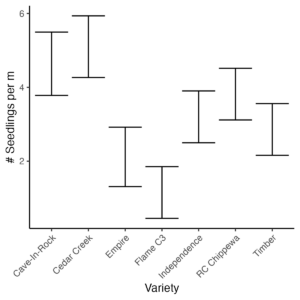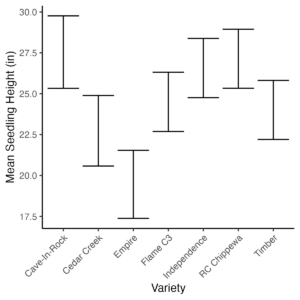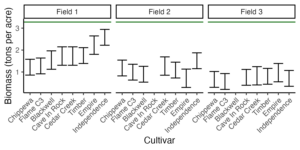Progress report for ONE22-428
Project Information
This project seeks to: (1) Evaluate four improved switchgrass cultivars and two improved big bluestem cultivars across three farms. (2) Measure 1st year grass seedling counts, 1st 2nd and 3rd year fall sward height and 2nd and 3rd year fall biomass yield. (3) Communicate results to interested parties through online communications, social media, a presentation at the Association of Warm Season Grass Producers annual meeting, and through formal publications.
Widespread adoption of native grass agriculture could diversify the landscape and rural economy. Specifically, native grasses can improve environmental outcomes while creating new markets for sustainable bio-products. Increasing the footprint of perennial crops on the landscape provides greater habitat for a range of insect, mammal, and bird species. Further, deep rooted perennials can increase soil carbon and reduce soil loss and nutrient run-off. For farmers, native grasses can be profitable by providing high-yield, low-input biomass or forage for livestock, particularly when grown on lands unsuitable for annual crops. Promising new incentives for farmers are also being proposed through carbon offsets credits or nutrient credits. In Pennsylvania specifically, nutrient credit programs such as Chesapeake Bay Nutrient Credit Trading program provides a model where farmers are paid for improved land management practices.
Despite these opportunities, perennial native grass adoption has been slow. This is driven by a chicken-and-egg issue where farmers are unwilling to adopt a crop that lacks an established marketplace. Further, without a robust community of farmers testing new methods and varieties, the best practices in native grass agronomics are uncertain. The Association of Warm Season Grass Producers is seeking to remedy both of these issues by collaborating to recruit buyers of grass biomass and to share insights among farmers regarding best practices. A recent opportunity has arisen because multiple member farmers have reported fields with low yields due to a combination of older varieties, weed build-up and disease pressure. These fields were established using a “first generation” switchgrass cultivar Cave-In-Rock, along with a mixture of big bluestem and other grassland species. Improved varieties could provide greater yield and disease resistance, but many new varieties have not been tested in the region. Establishment and yield data on improved native grass varieties can provide current farmers with valuable information and could make native grass production more appealing to prospective farmers.
Native grass establishment is currently risky due to the risk of failed or weak grass stands. Native grasses establish slowly and produce negligible yields during the first year and reduced yields during 2nd and 3rd season. Breeding programs have focused on improving native grass germination rates and seedling vigor. The strongest example of this is the program REAP Canada (Resource Efficient Agricultural Production) which has adopted a single-year breeding cycle based on vigorous upright growth during the establishment year. This program has developed multiple cultivars including RC Big Rock, a selection from the Cave-In-Rock switchgrass cultivar, and RC Crazy Horse, an improved big bluestem variety.
A second major source of improved varieties is through the adoption of lowland switchgrass ecotypes. Broadly, switchgrass occurs as two primary ecotypes: upland and lowland. Lowland ecotypes tend to grow in the southern United States, while upland ecotypes are native to the northern United States. The majority of farmers in the northeast region use an upland ecotype. Agronomically, lowland ecotypes have greater yield potential and are disease resistant. However, lowland ecotypes are prone to winterkill and poor vigor when grown in the northern United States. Recent breeding efforts, however, have created multiple winter-tolerant lowland cultivars. These lowland ecotypes can increase biomass yield by approximately 50%, but rigorous field comparisons have not occurred. Further, different breeding programs have released multiple lowland populations which have not been rigorously compared in the Northeast. This study proposes to evaluate the improved lowland switchgrass cultivars Timber, Independence, and Cedar Creek. Timber is a cultivar generated from multiple populations native to the Northeast and was released by the Cape May Plant Materials Center. Independence is a release from the University of Illinois and was created from individuals selected for high biomass and vigor from the cultivar Kanlow. Cedar Creek was created in Wisconsin from a Kanlow-derived breeding population which was selected for multiple cycles of winter survival as far north as plant hardiness zone 4.
Although more research effort has been dedicated to switchgrass, multiple breeding programs have also focused on improved big bluestem cultivars. Anecdotally, big bluestem has been successfully planted with switchgrass by farmers in the region and improves yield stability across growing seasons and fields. This study will evaluate two new populations: RC Crazy Horse and Empire. The RC Crazy Horse population was described above. The Empire big bluestem population was selected for late flowering, which extends biomass accumulation and improves fall yields.
This study can provide important yield data for farmers and may also provide information to reduce the risks of sward establishment. Combined, this will improve confidence of farmers in the Association of Warm Season Grass Producers and can also encourage other farmers with marginal or erodible land to establish native grasses. This work can supplement ongoing projects being carried out by Pennsylvania State University which are aimed at improving grass riparian buffer adoption and on-farm bioenergy production.
Cooperators
- - Producer
- - Technical Advisor (Researcher)
- - Technical Advisor
- (Researcher)
- - Producer
- - Producer
Research
In late May of 2023, the original sward was renovated using standard methods. Briefly, the swards were mowed and sprayed with glyphosate at the suggested rate prior to re-seeding. After seeding, the field was cultipacked to improve seed to soil contact. The six varieties will be planted using a John Deere 750 no-till grass seed drill at a rate equivalent to 4 lbs PLS per acre. Seed for four varieties were donated by Ernst Seeds and two varieties are being donated by active researchers. The experimental design is an incomplete block strip-plot design. Each grass variety was planted in a 30’ by 120’ strip with 2 replicates of each variety per farm. First and second year weed control included of 2,4-D at the suggested rate for control of broad-leaf weeds, and summer mowing to reduce weed competition.
Establishment success was measured by the following: After the first frost of 2024 and 2025, mean fall sward height will also be recorded every at four quadrants along of a transect running through the center of each plot. Biomass accumulation is negligible during the establishment year, but in 2024 and 2025 fall biomass yield is by hand clipping and weighing 9 square foot quadrats. Aboveground biomass were clipped at standard mowing height and weighed in-field using a hanging scale. One sample per plot was dried to calculate an adjustment for moisture content.
Analysis will be carried out using a fixed-effects model controlling for field locations and replicates. A random variety-by-farm interactive effect is also tested to measure the yield stability of different cultivars among farms. Further, plant height measurements are a surrogate for biomass yield.
This research project officially began August 1, 2022 and is expected to be carried out through November 30, 2025. The original project proposal plan is based on planting the six trial varieties of warm season grass on three separate farms in the spring of 2023. A pre-planting herbicide application plan was developed in the fall of 2022 by the researchers and participating producers. The necessary herbicide to be applied to the plots, plot marking stakes, and marking flags for the project have been purchased for the project. A WSG Variety Trial Spray Plan was prepared and provided to the participants.
One of the three original warm season grass producers committed to the project (Rodney Leighow) has notified us that he is declining to participate in the project for personal reasons, however, another agricultural landowner (Ann Roberts) has been added as the third farm to be planted with the trial varieties and evaluated for this project. The Roberts farm is leased to Bruce Trumbower who will actively carry out and manage that trial planting as well as the plantings on his own farm in collaboration with Neal Tilhou (researcher).
We were unable to source all of the six entries for the study in 2023. Specifically, RC Crazy Horse big bluestem seed and RC Big Rock switchgrass were unavailable. Also, seed was limited for both Empire big bluestem and Cedar Creek switchgrass. Therefore, the experimental design was altered to be an incomplete block design where Cedar Creek and Empire were replicated only once per site. RC Big Rock was replaced with RC Chippewa, which is a switchgrass population selected for the same traits with slightly earlier flowering time. RC Crazy Horse was replaced with an experimental cold tolerant lowland ecotype switchgrass population called FLAME C3. The remaining treatment was replaced with a single replicate per site of two well established upland switchgrass cultivars to serve as 'check' varieties: Cave-In-Rock and Blackwell. This resulted in four entries containing two replicates per site (RC Chippewa, Independence, Timber, and FLAME-C3) and four entries with one replicate per site (Cedar Creek, Empire, Blackwell, Cave-In-Rock). The actual final plot layout variety planting design described above of the "Renovating Native Grass Swards: An On-farm Trial of Improved Warm-Season Grass Varieties" Project is available to view using the link provided.
The planting occurred in spring of 2023 using a John Deere 8300 seed drill at a rate of 6 lbs per acre. Switchgrass establishment appeared to be successful, but there was strong first year weed pressure. Big bluestem was broadcast seed and establishment was uneven across the plots. Weed pressure, particularly yellow foxtail, was aggressive in year 2 (2024) and an additional spring herbicide application was required.
Summer height measurements and seeding counts were collected for 1 linear meter along a planted row at four points at each plot on July 8th, 2024. In December 12th, 2024, fall biomass was collected at four random 2.25 square meter quadrats in each plot.
A fixed effect model indicated that field and grass variety had highly significant effects on seedling establishment success (year 2 July seedling count; p<0.001). The mean number of seedlings per linear meter is 3.69 , which is less than ideal but sufficient for a successful stand. The seedling counts were different among test fields (Field 1: 4.12, Field 2: 4.73, Field 3 2.21), with low germination in a noticeably marginal site with shallow soils. Among varieties, Cave In Rock and Cedar Creek had the greatest seedling number and Flame C3 had the lowest seedling number. Broadcast seeding of Empire big bluestem resulted in uneven establishment of seedlings.
Seedling vigor was also measured through seedling height. There were significant effects (p<0.001) for field and grass variety. Similar to seedling counts, the marginal Field 3 had reduced seedling heights (Field 1: 27 in, Field 2: 24 in, Field 3: 19 in). The significant effect was primarily due to Empire big bluestem, with most switchgrass cultivars having similar seedling heights. Specifically, the big bluestem seedlings were shorter because they had not begun stem elongation while switchgrass seedlings had begun flowering in July of the 2nd year. The highest mean seedling heights were Cave-In-Rock, RC Chippewa, and Independence.
Generally, the native grass swards were not fully established in the 2nd year. Mean fall biomass harvest for the trial plots in the 2nd year was 1.19 tons per acre. This is low relative to the yield of 3.27 dry tons per acre in a nearby established native grass field of mixed big bluestem and switchgrass near Field 1. Also, a field of Timber switchgrass near Field 3 produced a mean of 5.57 dry tons per acre. This indicates that further establishment is required for these plots and the 2025 growing season will hopefully provide the first estimates of true commercial performance.
There was a highly significant effect due to field (p>0.001; Field 1: 1.74 tons per acre, Field 2: 1.11 tons per acre, Field 3: 0.73 tons per acre). Grass variety and grass variety-by-field had significant statistical effects on yield (p=0.028 and p=0.029, respectively). The interaction was due to a lack of meaningful grass variety variation in Fields 2 and 3. In the figure below, the horizontal green line indicates the biomass of the established mixed big bluestem switchgrass field. So far, the cultivar Independence is a strong performer in Field 1 and has the highest mean performance in Field 2.
Separately, a secondary experiment was established to test switchgrass establishment underneath an annual crop of grain sorghum. The producer reported 46 bu/ac harvest for sorghum and reported that switchgrass establishment was uneven but that there were clearly areas with established native grass crowns. Given the challenges establishing native grasses in the primary study, this is a promising area for future research.
A subset of the sorghum field was planted with no sorghum nurse crop and this area was heavily weed infested. Spring seedling counts are planned for 2025 to measure the variation in grass establishment success rates with and without grain sorghum.
Education & outreach activities and participation summary
Participation summary:
Initial discussions among the Association of Warm Season Grass Producers, the grantee principal investigator (Wes Ramsey), and Neal Tilhou (the project researcher) defined the intent of the project and prepared a pre-planting herbicide application plan in cooperation with the three producers identified as participants in the project.
The results of this study was communicated to the public through multiple channels. Preliminary results were presented at the Association of Warm Season Grass Producers meeting in 2024, and final results will be reported at the 2025 meeting. Final results will also be posted to the Association website https://www.awsgp.org/ and e-mail list consisting of over 300 members and the results will also be published on the Penn Soil RC&D Council website www.pennsoil.org and social media pages. The Association of Warm Season Grass Producers also regularly presents at Ag Progress Days and can include information about the results of this trial. Also, results will also be used to draft a peer-reviewed paper which would include entirely novel yield data for these grass varieties and this region.
In early spring of 2024, discussions took place between the research participants about additional research concepts that could be incorporated into this project due to some cost-saving measures that occurred within the first year of the project. Due to continued interest among producers in the Association of Warm Season Grass producers, we supported an additional on-farm experiment. These experiments could provide additional specific guidance for more affordable native grass establishment. This second experiment tested switchgrass establishment underneath cash crops, either for hay or grain. There are very few reports of this method and the strategy is, justifiably, considered risky since switchgrass seed is expensive. Tyson Myers was planning to establish native grasses after a grain sorghum crop. After discussion, he established switchgrass stand underneath a grain sorghum crop, with both planted in spring 2024. He seeded three promising and genetically distinct switchgrass varieties: Timber, Liberty, and Independence. Tyson Myers provided a preliminary planting report with images of the pre-treatment process and planting report and images of the first season growth which are added into the information products section of this report.
Learning Outcomes
We have not carried out outreach beyond the participating producers. Bruce Trumbower reported that 2024 was a rainy year and foxtail grass was aggressive and required two weed and grass control sprayings in May and June and one maintenance mowing in March on the three plots. Plot 1 grew the best, Plot two was second best, and plot 3 was third best by his observation. Timber switchgrass seemed the strongest in his opinion.


